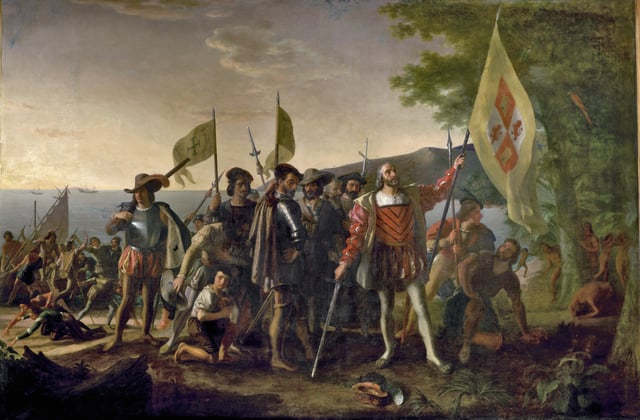The Bahamas
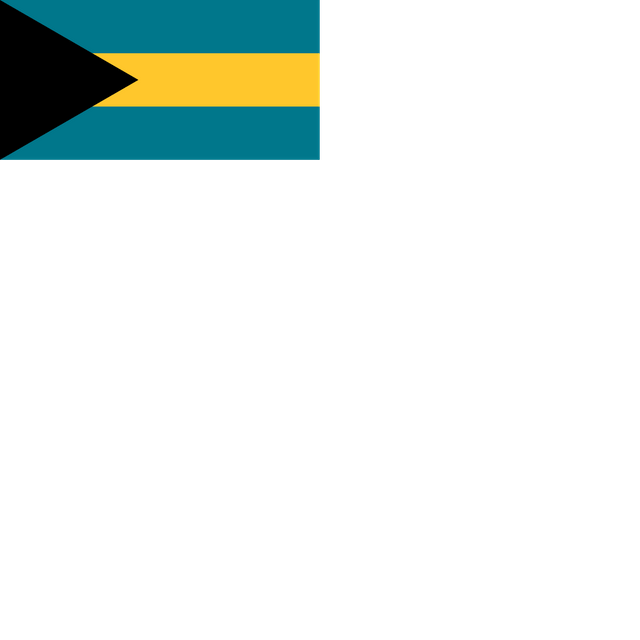
The Bahamas

| Capital | Nassau |
|---|---|
| Official languages | English |
| Vernacular language | Bahamian Creole |
| Ethnic groups | 92.7%African4.7%European2.1%Mixed1.9%American2.12% Other[1][2] |
| Demonym(s) | Bahamian |
| Government | |
| Elizabeth II | |
| Cornelius A. Smith | |
| Hubert Minnis | |
| Legislature | Parliament |
| Senate | |
| House of Assembly | |
| Independence | |
| 10 July 1973[5] | |
| Area | |
| 13,878 km (5,358 sq mi) (155th) | |
| 28% | |
| Population | |
| 391,232[6](177th) | |
| 351,461 | |
| 25.21/km (65.3/sq mi) (181st) | |
| GDP | 2018 estimate |
| $12.612 billion[7](148th) | |
| $33,494[7](40th) | |
| GDP | 2018 estimate |
| $12.803 billion[7](130th) | |
| $34,002[7](26th) | |
| HDI | |
| Currency | |
| Time zone | (EST) |
| (EDT) | |
| Driving side | left |
| Calling code | +1 242 |
| ISO 3166 code | BS |
| Internet TLD | .bs |
The Bahamas (/bəˈhɑːməz/ ( listen)), known officially as the Commonwealth of The Bahamas,, in the Caribbean. The archipelagic state consists of more than 700 islands, cays, and islets in the Atlantic Ocean, and is located north of Cuba and Hispaniola Island (Haiti and the Dominican Republic), northwest of the Turks and Caicos Islands, southeast of the U.S. state of Florida, and east of the Florida Keys. The capital is Nassau on the island of New Providence. The Royal Bahamas Defence Force describes The Bahamas' territory as encompassing 470,000 km2 (180,000 sq mi) of ocean space.
The Bahamas were inhabited by the Lucayans, a branch of the Arawakan-speaking Taíno people, for many centuries.[1] Columbus was the first European to see the islands, making his first landfall in the 'New World' in 1492. Later, the Spanish shipped the native Lucayans to slavery on Hispaniola, after which The Bahama islands were mostly deserted from 1513 until 1648, when English colonists from Bermuda settled on the island of Eleuthera.
The Bahamas became a British crown colony in 1718, when the British clamped down on piracy. After the American Revolutionary War, the Crown resettled thousands of American Loyalists to the Bahamas; they took their slaves with them and established plantations on land grants. African slaves and their descendants constituted the majority of the population from this period on. The slave trade was abolished by the British in 1807; slavery in the Bahamas was abolished in 1834. Subsequently, the Bahamas became a haven for freed African slaves. Africans liberated from illegal slave ships were resettled on the islands by the Royal Navy, while some North American slaves and Seminoles escaped to the Bahamas from Florida. Bahamians were even known to recognize the freedom of slaves carried by the ships of other nations which reached the Bahamas. Today Afro-Bahamians make up 90% of the population of 332,634.[1]
The Bahamas became an independent Commonwealth realm in 1973 with Elizabeth II as its queen.[1] In terms of gross domestic product per capita, the Bahamas is one of the richest countries in the Americas (following the United States and Canada), with an economy based on tourism and offshore finance.
| Capital | Nassau |
|---|---|
| Official languages | English |
| Vernacular language | Bahamian Creole |
| Ethnic groups | 92.7%African4.7%European2.1%Mixed1.9%American2.12% Other[1][2] |
| Demonym(s) | Bahamian |
| Government | |
| Elizabeth II | |
| Cornelius A. Smith | |
| Hubert Minnis | |
| Legislature | Parliament |
| Senate | |
| House of Assembly | |
| Independence | |
| 10 July 1973[5] | |
| Area | |
| 13,878 km (5,358 sq mi) (155th) | |
| 28% | |
| Population | |
| 391,232[6](177th) | |
| 351,461 | |
| 25.21/km (65.3/sq mi) (181st) | |
| GDP | 2018 estimate |
| $12.612 billion[7](148th) | |
| $33,494[7](40th) | |
| GDP | 2018 estimate |
| $12.803 billion[7](130th) | |
| $34,002[7](26th) | |
| HDI | |
| Currency | |
| Time zone | (EST) |
| (EDT) | |
| Driving side | left |
| Calling code | +1 242 |
| ISO 3166 code | BS |
| Internet TLD | .bs |
Etymology
The name Bahamas is most likely derived from either the Taíno ba ha ma ("big upper middle land"), which was a term for the region used by the indigenous people,[13]Bahama%20Saga%3A%20The%20epic%20story]]panish]] reflecting the shallow waters of the area. Alternatively, it may originate from Guanahani ng.[14]
The word The constitutes an integral part of the short form of the name and is, therefore, capitalized. So – in contrast to "the Congo" and "the United Kingdom" – it is proper to write "The Bahamas". The name The Bahamas is thus comparable with certain non-English names that also use the definite article, such as Las Vegas or Los Angeles. The Constitution of the Commonwealth of The Bahamas, the country's fundamental law, capitalizes the "T" in "The Bahamas".[15]
History
Pre-colonial era
The first inhabitants of the Bahamas were the Taino people, who moved into the uninhabited southern islands from Hispaniola and Cuba around the 800s–1000s AD, having migrated there from South America; they came to be known as the Lucayan people.[16] An estimated 30,000 Lucayans inhabited the Bahamas at the time of Christopher Columbus's arrival in 1492.
Arrival of the Spanish
Columbus's first landfall in what was to Europeans a 'New World' was on an island he named San Salvador (known to the Lucayans as Guanahani).[16] Whilst there is a general consensus that this island lay within the Bahamas, precisely which island Columbus landed on is a matter of scholarly debate.[16] Some researchers believe the site to be present-day San Salvador Island (formerly known as Watling's Island), situated in the southeastern Bahamas, whilst an alternative theory holds that Columbus landed to the southeast on Samana Cay, according to calculations made in 1986 by National Geographic writer and editor Joseph Judge, based on Columbus's log.[16] On the landfall island, Columbus made first contact with the Lucayans and exchanged goods with them, claiming the islands for Spain, before proceeding to explore the larger isles of the Greater Antilles.[16]
The 1494 Treaty of Tordesillas theoretically divided the new territories between Spain and Portugal, placing the Bahamas in the Spanish sphere; however they did little to press their claim on the ground.[16] The Spanish did however make use of the native Lucayan peoples, many of whom were enslaved and sent to Hispaniola for use as forced labour.[16] The slaves suffered from harsh conditions and most died from contracting diseases to which they had no immunity; half of the Taino died from smallpox alone.[18] As a result of these depredations the population of the Bahamas was severely diminished.[19]
Arrival of the English
The English had expressed an interest in the Bahamas as early as 1629,[16] however, it was not until 1648 that the first English settlers arrived on the islands.[16] Known as the Eleutherian Adventurers and led by William Sayle, they migrated to Bermuda seeking greater religious freedom.[16] These English Puritans established the first permanent European settlement on an island which they named 'Eleuthera', Greek for 'freedom'. They later settled New Providence, naming it Sayle's Island. Life proved harder than envisaged however, and many – including Sayle – chose to return to Bermuda.[16] To survive, the remaining settlers salvaged goods from wrecks.
In 1670, King Charles II granted the islands to the Lords Proprietors of the Carolinas in North America. They rented the islands from the king with rights of trading, tax, appointing governors, and administering the country from their base on New Providence.[20][16] Piracy and attacks from hostile foreign powers were a constant threat. In 1684, Spanish corsair Juan de Alcon raided the capital Charles Town (later renamed Nassau),[21] and in 1703, a joint Franco-Spanish expedition briefly occupied Nassau during the War of the Spanish Succession.[22][23]
18th century
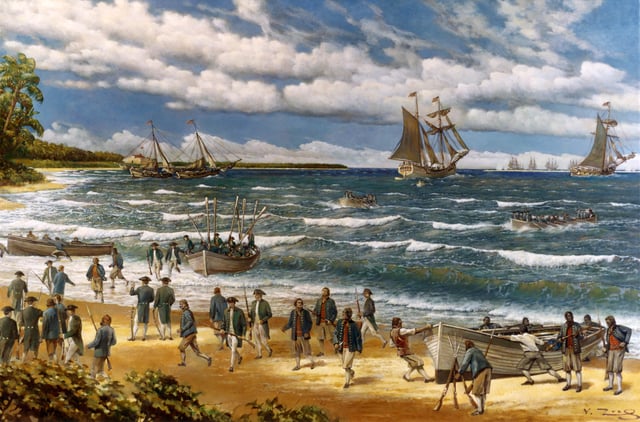
Continental Marines land at New Providence during the Battle of Nassau in 1776
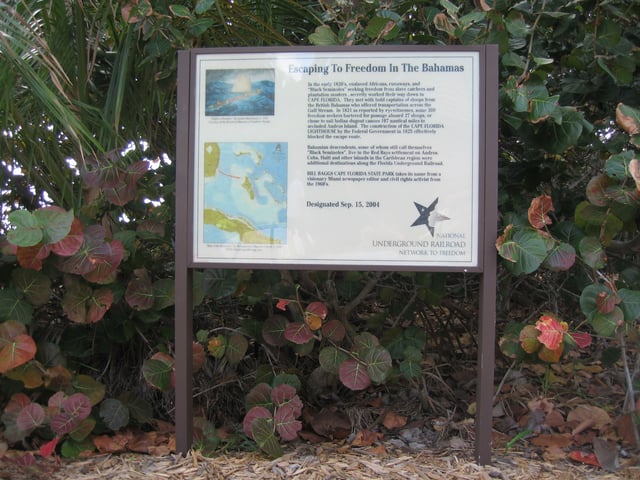
Sign at Bill Baggs Cape Florida State Park commemorating hundreds of African-American slaves who escaped to freedom in the early 1820s in the Bahamas
During proprietary rule, the Bahamas became a haven for pirates, including Blackbeard (circa 1680–1718).[24] To put an end to the 'Pirates' republic' and restore orderly government, Great Britain made the Bahamas a crown colony in 1718 under the royal governorship of Woodes Rogers.[16] After a difficult struggle, he succeeded in suppressing piracy.[25] In 1720, Rogers led local militia to drive off a Spanish attack during the War of the Quadruple Alliance.[26] In 1729, a local assembly was established giving a degree of self-governance for the English settlers.[16][27] The reforms had been planned by the previous Governor George Phenney and authorised in July 1728.[28]
During the American War of Independence in the late 18th century, the islands became a target for US naval forces under the command of Commodore Esek Hopkins; US Marines occupied Nassau for a brief period in 1776.[16] In 1782, following the British defeat at Yorktown, a Spanish fleet appeared off the coast of Nassau. The city surrendered without a fight.[16] Spain returned possession of the Bahamas to Great Britain the following year, under the terms of the Treaty of Paris.[16] Before the news was received however, the islands were recaptured by a small British force led by Andrew Deveaux.[16]
After US independence, the British resettled some 7,300 Loyalists with their African slaves in the Bahamas, including 2,000 from New York[29] and at least 1,033 whites, 2,214 blacks and a few Native American Creeks from East Florida. Most of the refugees resettled from New York had fled from other colonies, including West Florida, which the Spanish captured during the war.[30] The government granted land to the planters to help compensate for losses on the continent.[16] These Loyalists, who included Deveaux and also Lord Dunmore, established plantations on several islands and became a political force in the capital.[16] European Americans were outnumbered by the African-American slaves they brought with them, and ethnic Europeans remained a minority in the territory.
19th century
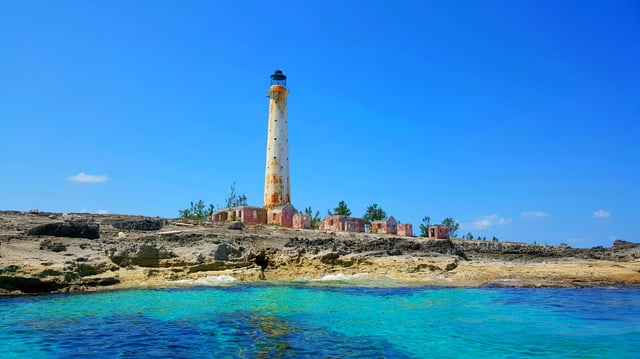
The lighthouse in Great Isaac Cay.
In 1807, the British abolished the slave trade.[16] During the following decades, the Royal Navy intercepted the trade; they resettled in The Bahamas thousands of Africans liberated from slave ships.
In the 1820s during the period of the Seminole Wars in Florida, hundreds of North American slaves and African Seminoles escaped from Cape Florida to the Bahamas. They settled mostly on northwest Andros Island, where they developed the village of Red Bays. From eyewitness accounts, 300 escaped in a mass flight in 1823, aided by Bahamians in 27 sloops, with others using canoes for the journey. This was commemorated in 2004 by a large sign at Bill Baggs Cape Florida State Park.[31][32] Some of their descendants in Red Bays continue African Seminole traditions in basket making and grave marking.[33]
In 1818,[34] the Home Office in London had ruled that "any slave brought to the Bahamas from outside the British West Indies would be manumitted." This led to a total of nearly 300 slaves owned by US nationals being freed from 1830 to 1835.[35] The American slave ships Comet and Encomium used in the United States domestic coastwise slave trade, were wrecked off Abaco Island in December 1830 and February 1834, respectively. When wreckers took the masters, passengers and slaves into Nassau, customs officers seized the slaves and British colonial officials freed them, over the protests of the Americans. There were 165 slaves on the Comet and 48 on the Encomium. The United Kingdom finally paid an indemnity to the United States in those two cases in 1855, under the Treaty of Claims of 1853, which settled several compensation cases between the two countries.[36][37]
Slavery was abolished in the British Empire on 1 August 1834.[16] After that British colonial officials freed 78 North American slaves from the Enterprise, which went into Bermuda in 1835; and 38 from the Hermosa, which wrecked off Abaco Island in 1840.[38] The most notable case was that of the Creole in 1841: as a result of a slave revolt on board, the leaders ordered the US brig to Nassau. It was carrying 135 slaves from Virginia destined for sale in New Orleans. The Bahamian officials freed the 128 slaves who chose to stay in the islands. The Creole case has been described as the "most successful slave revolt in U.S. history".[39]
These incidents, in which a total of 447 slaves belonging to US nationals were freed from 1830 to 1842, increased tension between the United States and the United Kingdom. They had been co-operating in patrols to suppress the international slave trade. However, worried about the stability of its large domestic slave trade and its value, the United States argued that the United Kingdom should not treat its domestic ships that came to its colonial ports under duress as part of the international trade. The United States worried that the success of the Creole slaves in gaining freedom would encourage more slave revolts on merchant ships.
During the American Civil War of the 1860s, the islands briefly prospered as a focus for blockade runners aiding the Confederate States.[40][41]
Early 20th century
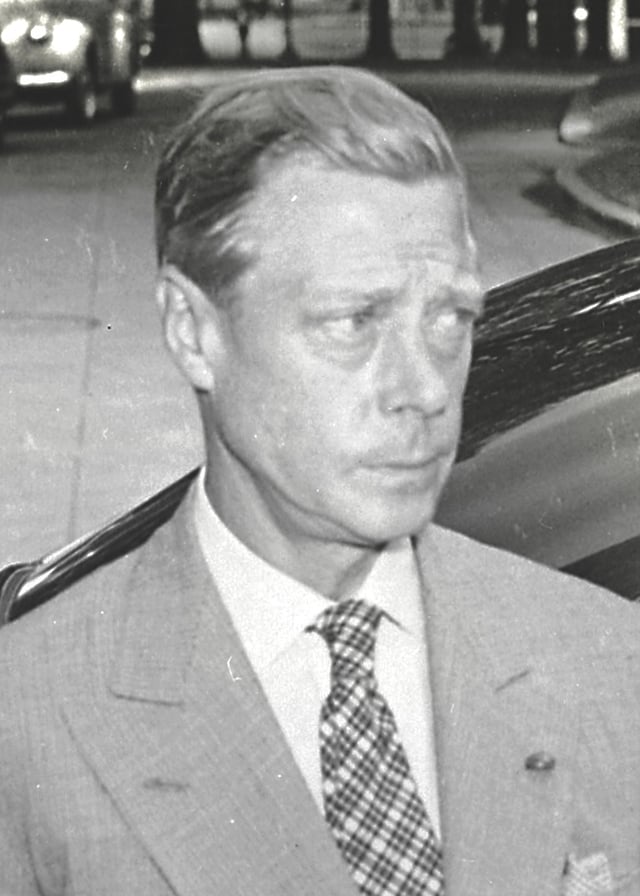
The Duke of Windsor (briefly King Edward VIII) and Governor of the Bahamas from 1940 to 1945
In August 1940, the Duke of Windsor was appointed governor of the Bahamas. He arrived in the colony with his wife. Although disheartened at the condition of Government House, they "tried to make the best of a bad situation".[42] He did not enjoy the position, and referred to the islands as "a third-class British colony".[43] He opened the small local parliament on 29 October 1940. The couple visited the "Out Islands" that November, on Axel Wenner-Gren's yacht, which caused controversy;[44] the British Foreign Office strenuously objected because they had been advised by United States intelligence that Wenner-Gren was a close friend of the Luftwaffe commander Hermann Göring of Nazi Germany.[44][43]
The Duke was praised at the time for his efforts to combat poverty on the islands.
A 1991 biography by Philip Ziegler, however, described him as contemptuous of the Bahamians and other non-European peoples of the Empire.
He was praised for his resolution of civil unrest over low wages in Nassau in June 1942, when there was a "full-scale riot".[46] Ziegler said that the Duke blamed the trouble on "mischief makers – communists" and "men of Central European Jewish descent, who had secured jobs as a pretext for obtaining a deferment of draft".[47] The Duke resigned from the post on 16 March 1945.[48][49]
Post-Second World War

The Bahamas used to be a Crown colony until it gained independence in 1973
Modern political development began after the Second World War. The first political parties were formed in the 1950s, split broadly along ethnic lines - the United Bahamian Party (UBP) representing the English-descended Bahamians (known informally as the 'Bay Street Boys'),[50] and the Progressive Liberal Party (PLP) representing the Afro-Bahamian majority.[16]
A new constitution granting the Bahamas internal autonomy went into effect on 7 January 1964, with Chief Minister Sir Roland Symonette of the UBP becoming the first Premier.[51] [52] In 1967, Lynden Pindling of the PLP became the first black Premier of the Bahamian colony; in 1968, the title of the position was changed to Prime Minister. In 1968, Pindling announced that the Bahamas would seek full independence.[53] A new constitution giving the Bahamas increased control over its own affairs was adopted in 1968.[54] In 1971, the UBP merged with a disaffected faction of the PLP to form a new party, the Free National Movement (FNM), a de-racialised, centre-right party which aimed to counter the growing power of Pindling's PLP.[55]
The British House of Lords voted to give the Bahamas its independence on 22 June 1973.[56] Prince Charles delivered the official documents to Prime Minister Lynden Pindling, officially declaring the Bahamas a fully independent nation on 10 July 1973.[57] It joined the Commonwealth of Nations on the same day.[58] Sir Milo Butler was appointed the first governor-general of the Bahamas (the official representative of Queen Elizabeth II) shortly after independence.
Post-independence
Shortly after independence, the Bahamas joined the International Monetary Fund and the World Bank on 22 August 1973,[59] and later the United Nations on 18 September 1973.[60]
Politically, the first two decades were dominated by Pindling's PLP, who went on to win a string of electoral victories.[16] Allegations of corruption, links with drug cartels and financial malfeasance within the Bahamian government failed to dent Pindling's popularity.[16] Meanwhile, the economy underwent a dramatic growth period fuelled by the twin pillars of tourism and offshore finance, significantly raising the standard of living on the islands.[16] The Bahamas' booming economy led to it becoming a beacon for immigrants, most notably from Haiti.[16]
In 1992, Pindling was unseated by Hubert Ingraham of the FNM.[51] Ingraham went on to win the 1997 Bahamian general election, before being defeated in 2002, when the PLP returned to power under Perry Christie.[51] Ingraham returned to power from 2007-2012, followed by Christie again from 2012-17.[16] With economic growth faltering, Bahamians re-elected the FNM in 2017, with Hubert Minnis becoming the fourth prime minister.[16]
Geography
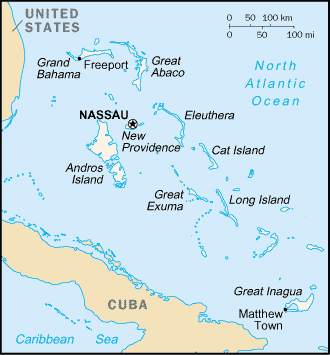
Map of the Bahamas

Damaged homes in the Bahamas in the aftermath of Hurricane Wilma in 2005
The Bahamas consists of a chain of islands spread out over some 500 miles in the Atlantic Ocean, located to the east of Florida in the United States, north of Cuba and Hispaniola and west of the British Overseas Territory of the Turks and Caicos Islands (with which it forms the Lucayan archipelago). It lies between latitudes 20° and 28°N, and longitudes 72° and 80°W and straddles the Tropic of Cancer.[1] There are some 700 islands and cays in total (of which 30 are inhabited) with a total land area of 10,010 km2 (3,860 sq mi).[1][64]
Nassau, capital city of the Bahamas, lies on the island of New Providence; the other main inhabited islands are Grand Bahama, Eleuthera, Cat Island, Rum Cay, Long Island, San Salvador Island, Ragged Island, Acklins, Crooked Island, Exuma, Berry Islands, Mayaguana, the Bimini islands, Great Abaco and Great Inagua. The largest island is Andros.[64]
All the islands are low and flat, with ridges that usually rise no more than 15 to 20 m (49 to 66 ft).
The highest point in the country is Mount Alvernia (formerly Como Hill) on Cat Island at 64m.[1]
Climate

The Bahamas map of Köppen climate classification.
The climate of the Bahamas is mostly tropical savannah climate or Aw according to Köppen climate classification. The low latitude, warm tropical Gulf Stream, and low elevation give the Bahamas a warm and winterless climate. The Bahamas have been free of snowfall, with the exception of snow mixed with rain reported in Freeport on the island of Grand Bahama on 19 January 1977.[65] Although every few decades low temperatures can fall below 10 °C (50 °F) for a few hours when a severe cold outbreak comes off the North American mainland, there is only a 7 °C difference between the warmest month and coolest month in most of the Bahama islands. As with most tropical climates, seasonal rainfall follows the sun, and summer is the wettest season. The Bahamas are often sunny and dry for long periods of time, and average more than 3,000 hours or 340 days[66] of sunlight annually.
Tropical storms and hurricanes can on occasion impact the Bahamas.
In 1992, Hurricane Andrew passed over the northern portions of the islands, and Hurricane Floyd passed near the eastern portions of the islands in 1999. Hurricane Dorian of 2019 passed over the archipelago at destructive Category 5 strength with sustained winds of 185 mph (295 km/h) and wind gusts up to 220 mph (354 km/h), becoming the strongest tropical cyclone on record to impact the northwestern islands of Grand Bahama and Great Abaco.[67]
| Climate data for Nassau | |||||||||||||
|---|---|---|---|---|---|---|---|---|---|---|---|---|---|
| Month | Jan | Feb | Mar | Apr | May | Jun | Jul | Aug | Sep | Oct | Nov | Dec | Year |
| Average high °C (°F) | 25.4(77.7) | 25.5(77.9) | 26.6(79.9) | 27.9(82.2) | 29.7(85.5) | 31.0(87.8) | 32.0(89.6) | 32.1(89.8) | 31.6(88.9) | 29.9(85.8) | 27.8(82.0) | 26.2(79.2) | 28.8(83.9) |
| Daily mean °C (°F) | 21.4(70.5) | 21.4(70.5) | 22.3(72.1) | 23.8(74.8) | 25.6(78.1) | 27.2(81.0) | 28.0(82.4) | 28.1(82.6) | 27.7(81.9) | 26.2(79.2) | 24.2(75.6) | 22.3(72.1) | 24.8(76.7) |
| Average low °C (°F) | 17.3(63.1) | 17.3(63.1) | 17.9(64.2) | 19.6(67.3) | 21.4(70.5) | 23.3(73.9) | 24.0(75.2) | 24.0(75.2) | 23.7(74.7) | 22.5(72.5) | 20.6(69.1) | 18.3(64.9) | 20.8(69.5) |
| Averageprecipitationmm (inches) | 39.4(1.55) | 49.5(1.95) | 54.4(2.14) | 69.3(2.73) | 105.9(4.17) | 218.2(8.59) | 160.8(6.33) | 235.7(9.28) | 164.1(6.46) | 161.8(6.37) | 80.5(3.17) | 49.8(1.96) | 1,389.4(54.70) |
| Average precipitation days | 8 | 6 | 7 | 8 | 10 | 15 | 17 | 19 | 17 | 15 | 10 | 8 | 140 |
| Mean monthlysunshine hours | 220.1 | 220.4 | 257.3 | 276.0 | 269.7 | 231.0 | 272.8 | 266.6 | 213.0 | 223.2 | 222.0 | 213.9 | 2,886 |
| Source:World Meteorological Organization( UN),[68]Hong Kong Observatory(sun only)[69] | |||||||||||||
| Jan | Feb | Mar | Apr | May | Jun | Jul | Aug | Sep | Oct | Nov | Dec |
|---|---|---|---|---|---|---|---|---|---|---|---|
| 23 °C 73 °F | 23 °C 73 °F | 24 °C 75 °F | 26 °C 79 °F | 27 °C 81 °F | 28 °C 82 °F | 28 °C 82 °F | 28 °C 82 °F | 28 °C 82 °F | 27 °C 81 °F | 26 °C 79 °F | 24 °C 75 °F |
Geology
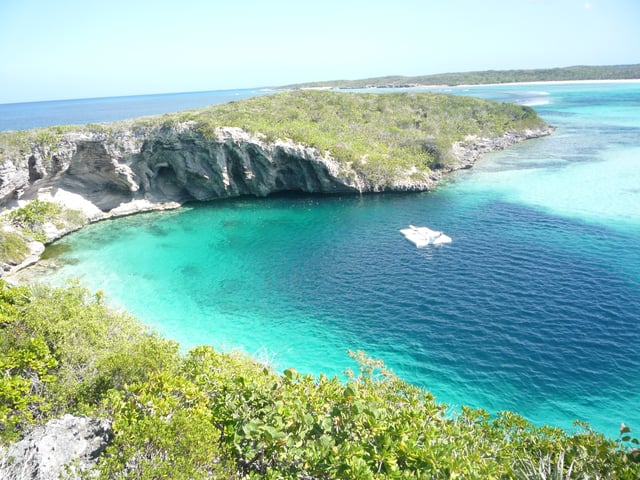
Dean's Blue Hole in Clarence Town on Long Island, Bahamas.
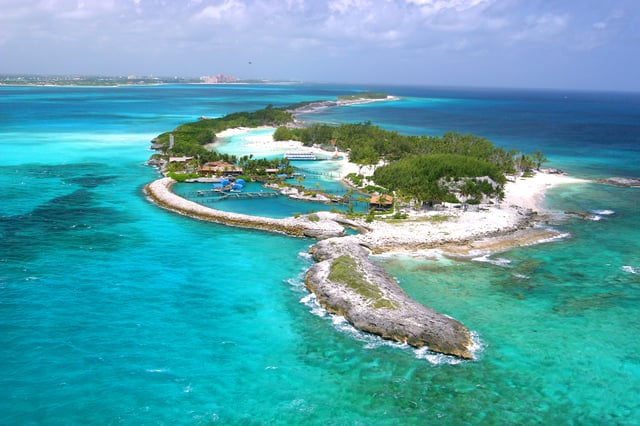
The Blue Lagoon Island, Bahamas.
The Bahamas is part of the Lucayan Archipelago, which continues into the Turks and Caicos Islands, the Mouchoir Bank, the Silver Bank, and the Navidad Bank.[70]
The Bahamas Platform, which includes the Bahamas, Southern Florida, Northern Cuba, the Turks and Caicos, and the Blake Plateau, formed about 150 Ma, not long after the formation of the North Atlantic. The 6.4 km (4.0 mi) thick limestones, which predominate in the Bahamas, date back to the Cretaceous. These limestones would have been deposited in shallow seas, assumed to be a stretched and thinned portion of the North American continental crust. Sediments were forming at about the same rate as the crust below was sinking due to the added weight. Thus, the entire area consisted of a large marine plain with some islands. Then, at about 80 Ma, the area became flooded by the Gulf Stream. This resulted in the drowning of the Blake Plateau, the separation of the Bahamas from Cuba and Florida, the separation of the southeastern Bahamas into separate banks, the creation of the Cay Sal Bank, plus the Little and Great Bahama Banks. Sedimentation from the "carbonate factory" of each bank, or atoll, continues today at the rate of about 2 cm per kyr. Coral reefs form the "retaining walls" of these atolls, within which oolites and pellets form.[71]
Coral growth was greater through the Tertiary, until the start of the Ice Ages, and hence those deposits are more abundant below a depth of 36 m. In fact, an ancient extinct reef exists half a km seaward of the present one, 30 m below sea level. Oolites form when oceanic water penetrate the shallow banks, increasing the temperature about 3 °C and the salinity by 0.5 per cent. Cemented ooids are referred to as grapestone. Additionally, giant stromatolites are found off the Exuma Cays.[71]
Sea level changes resulted in a drop in sea level, causing wind blown oolite to form sand dunes with distinct cross-bedding. Overlapping dunes form oolitic ridges, which become rapidly lithified through the action of rainwater, called eolianite. Most islands have ridges ranging from 30 to 45 m, though Cat Island has a ridge 60 m in height. The land between ridges is conducive to the formation of lakes and swamps.[71]
Solution weathering of the limestone results in a "Bahamian Karst" topography. This includes potholes, blue holes such as Dean's Blue Hole, sinkholes, beachrock such as the Bimini Road ("pavements of Atlantis"), limestone crust, caves due to the lack of rivers, and sea caves. Several blue holes are aligned along the South Andros Fault line. Tidal flats and tidal creeks are common, but the more impressive drainage patterns are formed by troughs and canyons such as Great Bahama Canyon with the evidence of turbidity currents and turbidite deposition.[71]
The stratigraphy of the islands consists of the Middle Pleistocene Owl's Hole Formation, overlain by the Late Pleistocene Grotto Beach Formation, and then the Holocene Rice Bay Formation. However, these units are not necessarily stacked on top of each other but can be located laterally. The oldest formation, Owl's Hole, is capped by a terra rosa paleosoil, as is the Grotto Beach, unless eroded. The Grotto Beach Formation is the most widespread.[70]
Government and politics
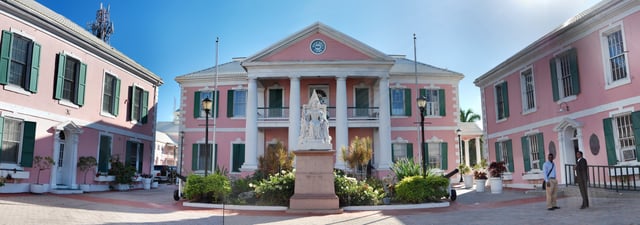
The Bahamian Parliament, located in Nassau
The Bahamas is a parliamentary constitutional monarchy, with the queen of the Bahamas (Elizabeth II) as head of state represented locally by a governor-general.[1] Political and legal traditions closely follow those of the United Kingdom and the Westminster system.[64] The Bahamas is a member of the Commonwealth of Nations and shares its head of state with other Commonwealth realms.
The prime minister is the head of government and is the leader of the party with the most seats in the House of Assembly.[1][64] Executive power is exercised by the Cabinet, selected by the prime minister and drawn from his supporters in the House of Assembly. The current governor-general is The Honourable Cornelius A. Smith, and the current prime minister is The Rt. Hon. Hubert Minnis MP.[1]
Legislative power is vested In a bicameral parliament, which consists of a 38-member House of Assembly (the lower house), with members elected from single-member districts, and a 16-member Senate, with members appointed by the governor-general, including nine on the advice of the Prime Minister, four on the advice of the leader of Her Majesty's Loyal Opposition, and three on the advice of the prime minister after consultation with the Leader of the Opposition. As under the Westminster system, the prime minister may dissolve Parliament and call a general election at any time within a five-year term.[72]
Constitutional safeguards include freedom of speech, press, worship, movement and association. The Judiciary of the Bahamas is independent of the executive and the legislature. Jurisprudence is based on English law.[1]
Political culture
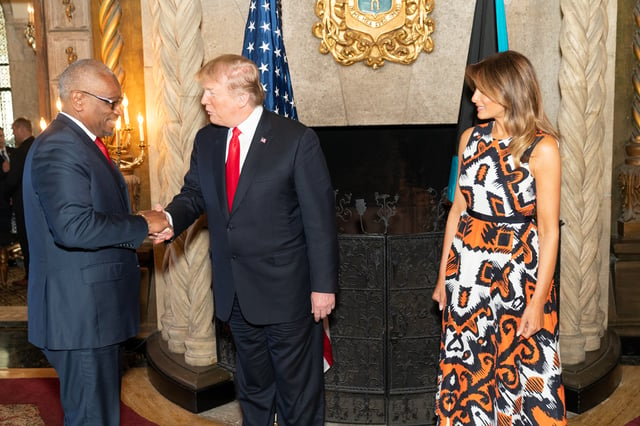
Bahamian Prime Minister Hubert Minnis with U.S. President Donald Trump on 22 March 2019
The Bahamas has a two-party system dominated by the centre-left Progressive Liberal Party and the centre-right Free National Movement. A handful of other political parties have been unable to win election to parliament; these have included the Bahamas Democratic Movement, the Coalition for Democratic Reform, Bahamian Nationalist Party and the Democratic National Alliance.
Foreign relations
The Bahamas has strong bilateral relationships with the United States and the United Kingdom, represented by an ambassador in Washington and High Commissioner in London. The Bahamas also associates closely with other nations of the Caribbean Community (CARICOM).
Armed forces

HMBS Nassau (P-61)
The Bahamanian military is the Royal Bahamas Defence Force (RBDF),[1] the navy of the Bahamas which includes a land unit called Commando Squadron (Regiment) and an Air Wing (Air Force).
Under the Defence Act, the RBDF has been mandated, in the name of the queen, to defend the Bahamas, protect its territorial integrity, patrol its waters, provide assistance and relief in times of disaster, maintain order in conjunction with the law enforcement agencies of the Bahamas, and carry out any such duties as determined by the National Security Council. The Defence Force is also a member of the Caribbean Community (CARICOM)'s Regional Security Task Force.
The RBDF came into existence on 31 March 1980.
Its duties include defending the Bahamas, stopping drug smuggling, illegal immigration and poaching, and providing assistance to mariners. The Defence Force has a fleet of 26 coastal and inshore patrol craft along with 3 aircraft and over 1,100 personnel including 65 officers and 74 women.
Administrative divisions
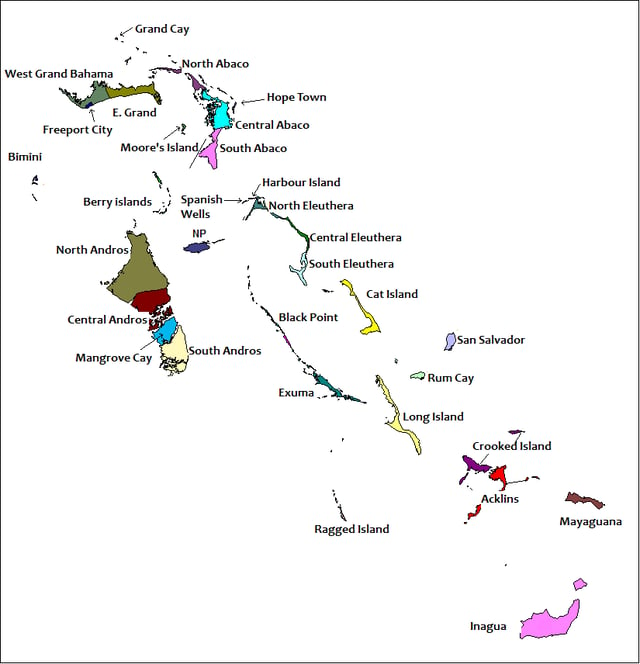
Districts of the Bahamas
The districts of the Bahamas provide a system of local government everywhere except New Providence (which holds 70% of the national population), whose affairs are handled directly by the central government. In 1996, the Bahamian Parliament passed the "Local Government Act" to facilitate the establishment of family island administrators, local government districts, local district councillors and local town committees for the various island communities. The overall goal of this act is to allow the various elected leaders to govern and oversee the affairs of their respective districts without the interference of the central government. In total, there are 32 districts, with elections being held every five years. There are 110 councillors and 281 town committee members elected to represent the various districts.[73]
Each councillor or town committee member is responsible for the proper use of public funds for the maintenance and development of their constituency.
The districts other than New Providence are:
Acklins
Berry Islands
Bimini
Black Point, Exuma
Cat Island
Central Abaco
Central Andros
Central Eleuthera
City of Freeport, Grand Bahama
Crooked Island
East Grand Bahama
Grand Cay, Abaco
Harbour Island, Eleuthera
Hope Town, Abaco
Inagua
Long Island
Mangrove Cay, Andros
Mayaguana
Moore's Island, Abaco
North Abaco
North Andros
North Eleuthera
Ragged Island
Rum Cay
San Salvador
South Abaco
South Andros
South Eleuthera
Spanish Wells, Eleuthera
West Grand Bahama
National flag

The national flag of the Bahamas
The Bahamian flag was adopted in 1973.
Its colours symbolise the strength of the Bahamian people; its design reflects aspects of the natural environment (sun and sea) and economic and social development.[1] The flag is a black equilateral triangle against the mast, superimposed on a horizontal background made up of three equal stripes of aquamarine, gold and aquamarine.[1]
Coat of arms

Bahamian Coat of Arms
The coat of arms of the Bahamas contains a shield with the national symbols as its focal point.
The shield is supported by a marlin and a flamingo, which are the national animals of the Bahamas. The flamingo is located on the land, and the marlin on the sea, indicating the geography of the islands.
On top of the shield is a conch shell, which represents the varied marine life of the island chain.
The conch shell rests on a helmet.
Below this is the actual shield, the main symbol of which is a ship representing the Santa María of Christopher Columbus, shown sailing beneath the sun. Along the bottom, below the shield appears a banner upon which is the national motto:[74]
"Forward, Upward, Onward Together."
National flower
The yellow elder was chosen as the national flower of the Bahamas because it is native to the Bahama islands, and it blooms throughout the year.
Selection of the yellow elder over many other flowers was made through the combined popular vote of members of all four of New Providence's garden clubs of the 1970s—the Nassau Garden Club, the Carver Garden Club, the International Garden Club and the YWCA Garden Club. They reasoned that other flowers grown there—such as the bougainvillea, hibiscus and poinciana—had already been chosen as the national flowers of other countries. The yellow elder, on the other hand, was unclaimed by other countries (although it is now also the national flower of the United States Virgin Islands) and also the yellow elder is native to the family islands.[75]
Economy
By the terms of GDP per capita, the Bahamas is one of the richest countries in the Americas.[76] Its currency (the Bahamian dollar) is kept at a 1-to-1 peg with the US dollar. It was revealed in the Panama Papers that the Bahamas is the jurisdiction with the most offshore entities or companies.[77]
Tourism

The Atlantis Paradise Island in Nassau
The Bahamas relies heavily on tourism to generate most of its economic activity. Tourism as an industry not only accounts for about 50% of the Bahamian GDP, but also provides jobs for about half of the country's workforce.[78] The Bahamas attracted 5.8 million visitors in 2012, more than 70% of whom were cruise visitors.
Financial services
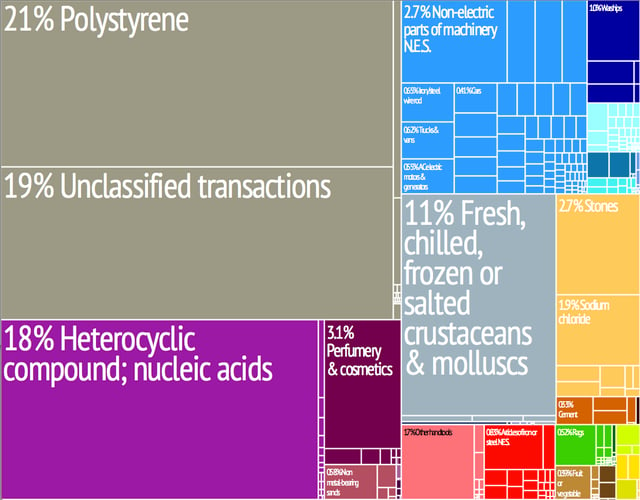
A proportional representation of the Bahamas exports.
After tourism, the next most important economic sector is banking and offshore international financial services, accounting for some 15% of GDP.
The government has adopted incentives to encourage foreign financial business, and further banking and finance reforms are in progress.
The government plans to merge the regulatory functions of key financial institutions, including the Central Bank of the Bahamas (CBB) and the Securities and Exchange Commission. The Central Bank administers restrictions and controls on capital and money market instruments. The Bahamas International Securities Exchange consists of 19 listed public companies. Reflecting the relative soundness of the banking system (mostly populated by Canadian banks), the impact of the global financial crisis on the financial sector was limited.
The economy has a very competitive tax regime (classified by some as a tax haven). The government derives its revenue from import tariffs, VAT, licence fees, property and stamp taxes, but there is no income tax, corporate tax, capital gains tax, or wealth tax. Payroll taxes fund social insurance benefits and amount to 3.9% paid by the employee and 5.9% paid by the employer.[79] In 2010, overall tax revenue as a percentage of GDP was 17.2%.[1]
Agriculture and manufacturing
Agriculture and manufacturing form the third largest sector of the Bahamian economy, representing 5–7% of total GDP.
An estimated 80% of the Bahamian food supply is imported.
Major crops include onions, okra, tomatoes, oranges, grapefruit, cucumbers, sugar cane, lemons, limes, and sweet potatoes.
Logistics
Supporting new break bulk operations in Freeport would help facilitate the emergence of high-value light assembly manufacturing in the port region.
Reforms that promote customs transparency and efficiencies are a key first step.[80]
Demographics
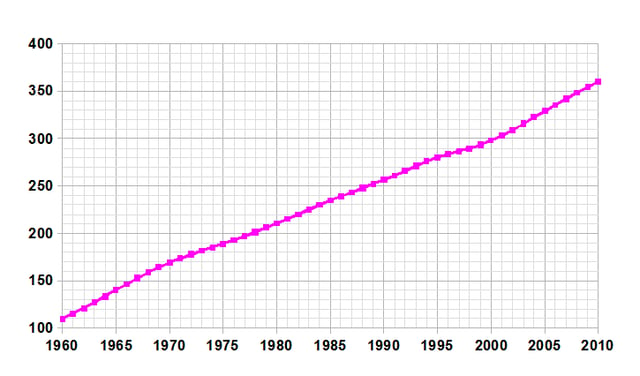
Demographics of Bahamas, data of FAO; number of inhabitants in thousands
The Bahamas has an estimated population of 391,232, of which 25.9% are 14 or under, 67.2% 15 to 64 and 6.9% over 65.
It has a population growth rate of 0.925% (2010), with a birth rate of 17.81/1,000 population, death rate of 9.35/1,000, and net migration rate of −2.13 migrant(s)/1,000 population.[81] The infant mortality rate is 23.21 deaths/1,000 live births. Residents have a life expectancy at birth of 69.87 years: 73.49 years for females, 66.32 years for males. The total fertility rate is 2.0 children born/woman (2010).[1]
The most populous islands are New Providence, where Nassau, the capital and largest city, is located;, home to the second largest city of Freeport.[83]
Racial and ethnic groups
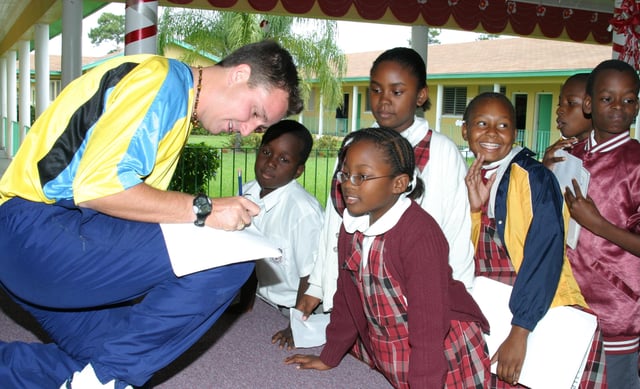
Afro-Bahamian children at a local school
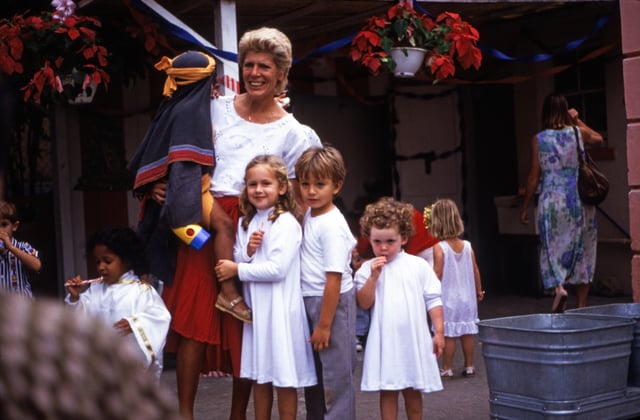
White Bahamians on the island of New Providence
According to the 99% response rate obtained from the race question on the 2010 Census questionnaire, 90.6% of the population identified themselves as being Black, 4.7% White and 2.1% of a mixed race (African and European).[84] Three centuries prior, in 1722 when the first official census of the Bahamas was taken, 74% of the population was native European and 26% native African.[84]
Since the colonial era of plantations, Africans or Afro-Bahamians have been the largest ethnic group in the Bahamas, whose primary ancestry was based in West Africa. The first Africans to arrive to the Bahamas were freed slaves from Bermuda; they arrived with the Eleutheran Adventurers looking for new lives.
The Haitian community in the Bahamas is also largely of African descent and numbers about 80,000. Due to an extremely high immigration of Haitians to the Bahamas, the Bahamian government started deporting illegal Haitian immigrants to their homeland in late 2014.[85]
The white Bahamian population are mainly the descendants of the English Puritans and American Loyalists escaping the American Revolution who arrived in 1649 and 1783, respectively.[86] Many Southern Loyalists went to the Abaco Islands, half of whose population was of European descent as of 1985.[87] The term white is usually used to identify Bahamians with Anglo ancestry, as well as "light-skinned" Afro-Bahamians. Sometimes Bahamians use the term Conchy Joe to describe people of Anglo descent.[88]
Bahamians typically identify themselves simply as either black or white.[88]
Religion
The islands' population is predominantly Christian.[64] Protestant denominations collectively account for more than 70% of the population, with Baptists representing 35% of the population, Anglicans 15%, Pentecostals 8%, Church of God 5%, Seventh-day Adventists 5% and Methodists 4%. There is also a significant Roman Catholic community accounting for about 14%.[93] There are also smaller communities of Jews, Muslims, Baha'is, Hindus, Rastafarians and practitioners of traditional African religions such as Obeah.
Languages
The official language of the Bahamas is English. Many people speak an English-based creole language called Bahamian dialect (known simply as "dialect") or "Bahamianese".[94] Laurente Gibbs, a Bahamian writer and actor, was the first to coin the latter name in a poem and has since promoted its usage.[95][96] Both are used as autoglossonyms [134].[97] Haitian Creole, a French-based creole language is spoken by Haitians and their descendants, who make up of about 25% of the total population. It is known simply as Creole [1] to differentiate it from Bahamian English.[98]
Culture
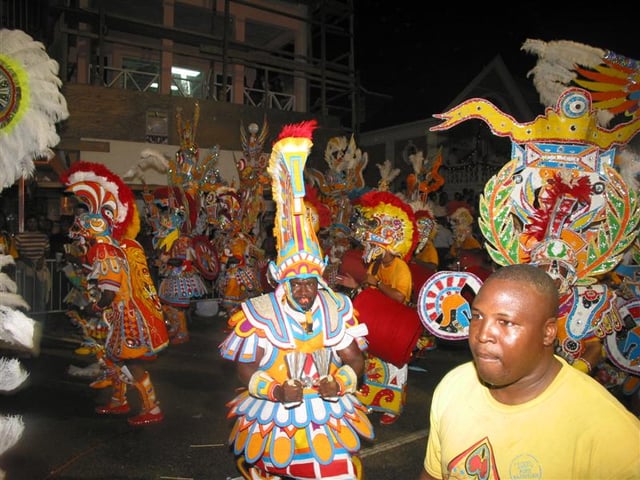
Junkanoo celebration in Nassau
The culture of the islands is a mixture of African (Afro-Bahamians being the largest ethnicity), British (as the former colonial power) and American (as the dominant country in the region and source of most tourists).[64]
In the less developed outer islands (or Family Islands), handicrafts include basketry made from palm fronds.
This material, commonly called "straw", is plaited into hats and bags that are popular tourist items.
Another use is for so-called "Voodoo dolls", even though such dolls are the result of foreign influences and not based in historic fact.[101]
Junkanoo is a traditional Afro-Bahamian street parade of 'rushing', music, dance and art held in Nassau (and a few other settlements) every Boxing Day and New Year's Day. Junkanoo is also used to celebrate other holidays and events such as Emancipation Day.[64]
Regattas are important social events in many family island settlements. They usually feature one or more days of sailing by old-fashioned work boats, as well as an onshore festival.
Many dishes are associated with Bahamian cuisine, which reflects Caribbean, African and European influences. Some settlements have festivals associated with the traditional crop or food of that area, such as the "Pineapple Fest" in Gregory Town, Eleuthera or the "Crab Fest" on Andros. Other significant traditions include story telling.
Bahamians have created a rich literature of poetry, short stories, plays and short fictional works.
Common themes in these works are (1) an awareness of change, (2) a striving for sophistication, (3) a search for identity, (4) nostalgia for the old ways and (5) an appreciation of beauty.
Some major writers are Susan Wallace, Percival Miller, Robert Johnson, Raymond Brown, O.M.
Smith, William Johnson, Eddie Minnis and Winston Saunders.[102][103]
Bahamas culture is rich with beliefs, traditions, folklore and legend.
The best-known folklore and legends in the Bahamas include the lusca and chickcharney creatures of Andros, Pretty Molly on Exuma Bahamas and the Lost City of Atlantis on Bimini Bahamas.
Sport
Sport is a significant part of Bahamian culture.
The national sport is cricket. Cricket has been played in the Bahamas from 1846, was formed in 1936, and from the 1940s to the 1970s, cricket was played amongst many Bahamians. Bahamas is not a part of the West Indies Cricket Board, so players are not eligible to play for the West Indies cricket team. The late 1970s saw the game begin to decline in the country as teachers, who had previously come from the United Kingdom with a passion for cricket, were replaced by teachers who had been trained in the United States. The Bahamian physical education teachers had no knowledge of the game and instead taught track and field, basketball, baseball, softball,[105] volleyball[106] and Association football[107] where primary and high schools compete against each other. Today cricket is still enjoyed by a few locals and immigrants in the country, usually from Jamaica, Guyana, Haiti and Barbados. Cricket is played on Saturdays and Sundays at Windsor Park and Haynes Oval.
The only other sporting event that began before cricket was horse racing, which started in 1796. The most popular spectator sports are those imported from the United States, such as basketball,[108] American football,[109] and baseball,[110] rather than from the British Isles, due to the country's close proximity to the United States, unlike their other Caribbean counterparts, where cricket, rugby, and netball have proven to be more popular.
Dexter Cambridge, Rick Fox, Ian Lockhart, Magnum Rolle, Buddy Hield and Deandre Ayton are a few Bahamians who joined Bahamian Mychal Thompson of the Los Angeles Lakers in the NBA ranks.[111][112] Over the years American football has become much more popular than soccer, though not implemented in the high school system yet. Leagues for teens and adults have been developed by the Bahamas American Football Federation.[113] However soccer, as it is commonly known in the country, is still a very popular sport amongst high school pupils. Leagues are governed by the Bahamas Football Association. Recently, the Bahamian government has been working closely with Tottenham Hotspur of London to promote the sport in the country as well as promoting the Bahamas in the European market. In 2013, 'Spurs' became the first Premier League club to play an exhibition match in the Bahamas, facing the Jamaican national team. Joe Lewis, the owner of the club, is based in the Bahamas.[114]
Other popular sports are swimming,[115] tennis[116] and boxing,,,,[120] beach soccer,[121] and netball are considered growing sports. Athletics, commonly known as 'track and field' in the country, is the most successful sport by far amongst Bahamians. Bahamians have a strong tradition in the sprints and jumps. Track and field is probably the most popular spectator sport in the country next to basketball due to their success over the years. Triathlons are gaining popularity in Nassau and the Family Islands.
Bahamians have gone on to win numerous track and field medals at the Olympic Games, IAAF World Championships in Athletics, Commonwealth Games and Pan American Games. Frank Rutherford is the first athletics olympic medallist for the country. He won a bronze medal for triple jump during the 1992 Summer Olympics.[122] Pauline Davis-Thompson, Debbie Ferguson, Chandra Sturrup, Savatheda Fynes and Eldece Clarke-Lewis teamed up for the first athletics Olympic Gold medal for the country when they won the 4 × 100 m relay at the 2000 Summer Olympics. They are affectionately known as the "Golden Girls".[123] Tonique Williams-Darling became the first athletics individual Olympic gold medallist when she won the 400m sprint in 2004 Summer Olympics.[124] In 2007, with the disqualification of Marion Jones, Pauline Davis-Thompson was advanced to the gold medal position in the 200 metres at the 2000 Olympics, predating William-Darling.
The Bahamas were hosts of the first men's senior FIFA tournament to be staged in the Caribbean, the 2017 FIFA Beach Soccer World Cup.[125] The Bahamas also hosted the first 3 editions of the IAAF World Relays.
Education
According to 1995 estimates, 98.2% of the Bahamian adult population are literate.
The University of the Bahamas (UB) is the national higher education/tertiary system. Offering baccalaureate, masters and associate degrees, UB has three campuses, and teaching and research centres throughout the Bahamas. The University of the Bahamas was chartered on 10 November 2016.
Transport
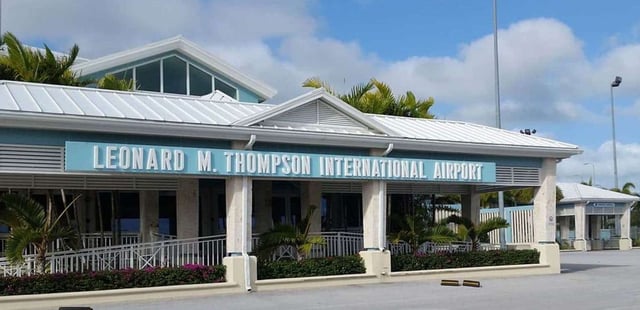
Leonard M. Thompson International Airport
The Bahamas contains about 1,620 km (1,010 mi) of paved roads.[1] Inter-island transport is conducted primarily via ship and air.
The country has 61 airports, the chief of which are Lynden Pindling International Airport on New Providence, Grand Bahama International Airport on Grand Bahama Island and Leonard M. Thompson International Airport (formerly Marsh Harbour Airport) on Abaco Island.
See also
Outline of the Bahamas
Index of Bahamas-related articles
Bahamas – Wikipedia book
